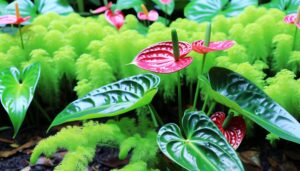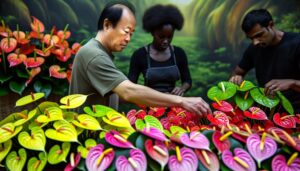The Meaning of Anthurium Plants: A Guide
Anthurium plants symbolize hospitality, happiness, and love. Red signifies love, pink for compassion, white for purity, and green for health.
These tropical beauties flourish in bright, indirect light and high humidity. Keep the soil moist but not waterlogged, and ensure temperatures remain between 70-85°F.
Use well-draining soil and pots with drainage holes. Fertilize monthly with diluted, balanced fertilizer.
Prune regularly, removing dead or yellow leaves. Watch out for common pests like spider mites and diseases like root rot.
By mastering these basics, you’ll unleash the full potential of your Anthurium plant.
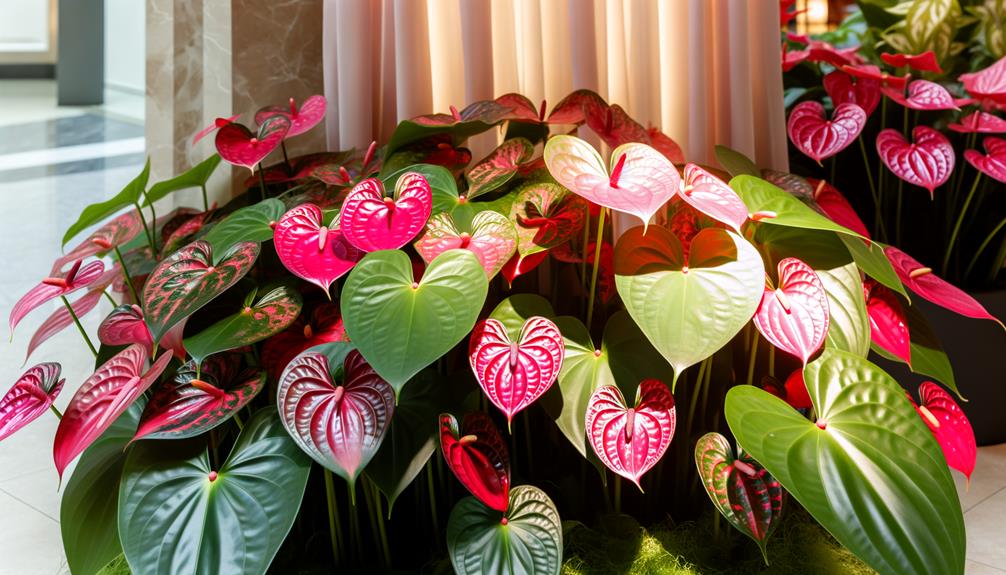
Key Takeaways
- Anthuriums symbolize hospitality, happiness, and various meanings based on color: red for love, pink for compassion, white for purity, and green for health.
- Place Anthuriums in bright, indirect sunlight for 6-8 hours daily to ensure healthy growth and vibrant blooms.
- Water thoroughly, allowing the top inch of soil to dry between waterings, and maintain high humidity levels for optimal health.
- Use a balanced, water-soluble fertilizer diluted to half strength monthly during the growing season to provide essential nutrients.
- Watch for common pests like spider mites and manage diseases through proper drainage and appropriate treatments.
Symbolism of Anthuriums
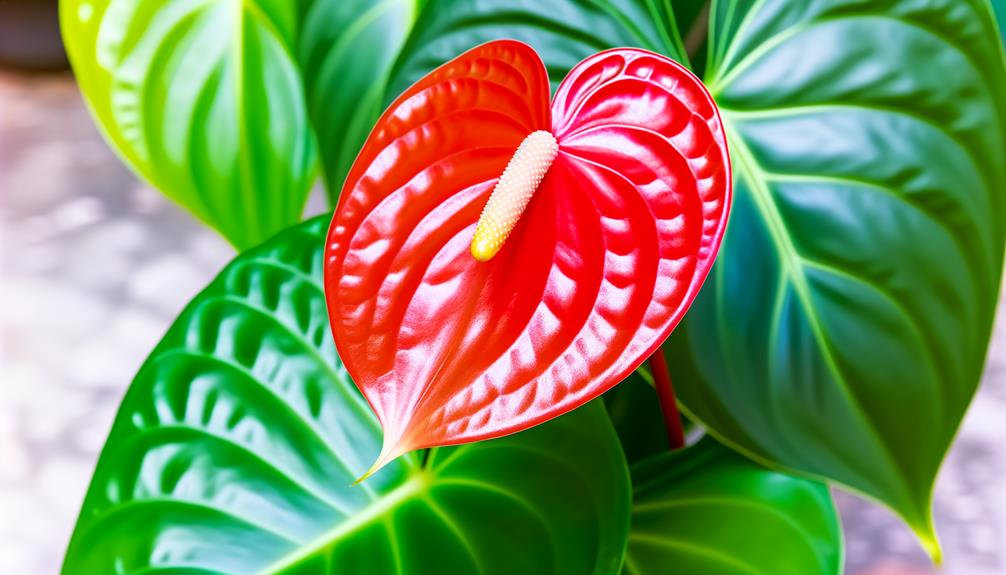
Anthuriums, often known as flamingo flowers, symbolize hospitality and happiness due to their vibrant, heart-shaped spathes.
Each color carries distinct meanings: red for love, pink for compassion, white for purity, and green for health.
To maintain their spiritual significance, follow these care guidelines: provide indirect light, keep soil moist but not waterlogged, and guarantee temperatures between 70-85°F.
Pruning techniques are essential for promoting healthy growth. Trim dead or yellowing leaves and faded flowers to encourage new blooms. This not only enhances their appearance but also revitalizes their energy, reinforcing their positive symbolism.
Historical Significance
You’ll find that Anthurium plants have fascinating historical significance rooted in ancient cultural beliefs and mythology.
Historically, various cultures attributed symbolic meanings to these plants, often linking them to themes of love, hospitality, and protection.
Understanding these ancient perspectives can enrich your appreciation and care of Anthuriums today.
Ancient Cultural Beliefs
Throughout history, various cultures have imbued Anthurium plants with rich symbolism, often associating them with hospitality, happiness, and abundance.
You’ll find that belief origins and cultural practices around Anthurium plants are deeply rooted in ancient traditions. For instance, in some South American cultures, they were used in spiritual ceremonies due to their vibrant colors and unique shapes.
| Culture | Belief Origins |
|---|---|
| South America | Used in spiritual ceremonies |
| Hawaii | Symbol of hospitality |
| Caribbean | Associated with happiness |
Traditional uses of the Anthurium plant often included placing them in homes to invite positivity and good fortune.
Their spiritual connections made them a centerpiece in rituals aimed at enhancing communal harmony and personal well-being.
Understanding these ancient cultural beliefs can enrich your appreciation of these fascinating plants.
Mythology and Symbolism
Many ancient myths and legends feature Anthurium plants, attributing them with powerful symbolism linked to love, luck, and prosperity.
In various cultures, the mythological origins of Anthurium plants are deeply entwined with stories of gods and spirits. For example, ancient Greek mythology often connected these plants with the gods of love, highlighting their heart-shaped leaves as symbols of affection and romance.
In historical context, Anthuriums were believed to bring good fortune and were frequently used in rituals and ceremonies.
Cultural beliefs from regions such as the Caribbean and South America also emphasize their role in promoting prosperity and warding off negative energy.
Understanding this rich symbolism helps you appreciate the deep-rooted significance of Anthuriums beyond their aesthetic appeal.
Cultural Associations
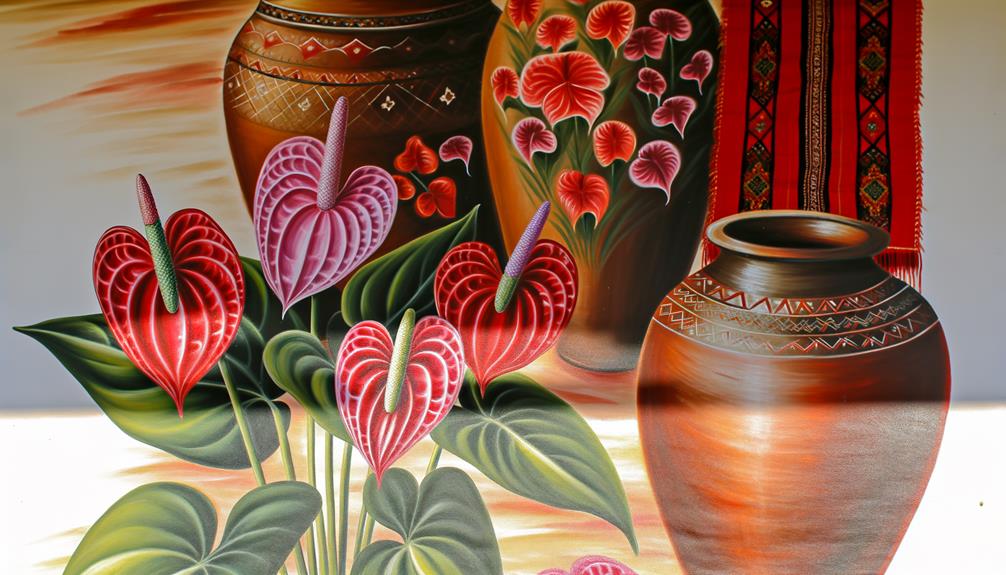
You’ll find that anthurium plants hold varied symbolism across cultures, often representing hospitality and abundance. They’ve played significant roles in historical contexts worldwide, influencing art and literature.
Additionally, anthuriums are integral to various rituals and traditions, underscoring their cultural importance.
Symbolism in Different Cultures
In various cultures around the world, anthurium plants are revered for their unique symbolism and associations with hospitality, love, and abundance. The vibrant red color of anthurium flowers often symbolizes passion and warmth, reflecting their role in welcoming guests.
In tropical cultures, these plants are integral to ancestral traditions, embodying a connection to the earth and the spirits of forebears. For example, in Hawaiian culture, anthuriums are believed to bring good luck and are often used in leis and ceremonial decorations.
The heart-shaped leaves further emphasize their connection to love and care, making them popular in both domestic and ceremonial contexts. Understanding these cultural associations can deepen your appreciation for the anthurium’s role in various traditions.
Historical Significance Worldwide
Exploring the historical significance of anthurium plants reveals their deep roots in various cultures, where they’ve been cherished for their aesthetic beauty and symbolic meanings. Their global impact and cultural significance are evident through various traditions and historical contexts.
- Hawaiian Culture: Anthuriums are often associated with hospitality and are a common sight in Hawaiian leis, symbolizing warmth and welcome.
- Victorian Era: In Europe, particularly during the Victorian era, anthuriums were prized for their exotic appearance and were often used in elaborate floral arrangements to convey sophistication.
- South American Heritage: Indigenous cultures in South America have valued anthuriums for centuries, often integrating them into rituals and celebrations due to their vibrant colors and unique shapes.
Understanding these historical roots deepens your appreciation for this plant’s rich symbolism.
Rituals and Traditions
Rituals and traditions surrounding anthurium plants highlight their deep cultural associations and the roles they play in ceremonies, festivities, and daily life.
In various cultures, anthuriums are integral in ceremonial practices due to their vibrant appearance and symbolic meanings. Traditional beliefs often link these plants to notions of hospitality, happiness, and abundance.
You’ll find them used in weddings, religious rituals, and as offerings during important events. Their striking red spathes make them a popular choice for decorations and gifts, symbolizing love and friendship.
| Ceremony/Event | Role of Anthuriums |
|---|---|
| Weddings | Symbolize love and abundance |
| Religious Rituals | Used as sacred offerings |
| Festivals | Decorative elements for celebration |
| Daily Life | Represent hospitality and joy |
| Funerals | Honor the deceased and symbolize peace |
Understanding these customs enhances your appreciation of anthuriums.
Choosing the Right Anthurium
When selecting the ideal Anthurium for your space, it’s crucial to consider factors such as light conditions, humidity levels, and the specific care requirements of different species.
Anthuriums are fantastic for indoor decor but require careful plant selection to thrive. Here are some care tips to guide your choice:
- Assess Light Conditions: Make sure your chosen species can tolerate the light available in your home.
- Evaluate Humidity Levels: Anthuriums thrive in high humidity, so choose a species that matches your environment.
- Understand Care Requirements: Different species have unique needs. Research to find one that fits your ability to provide care.
Light Requirements
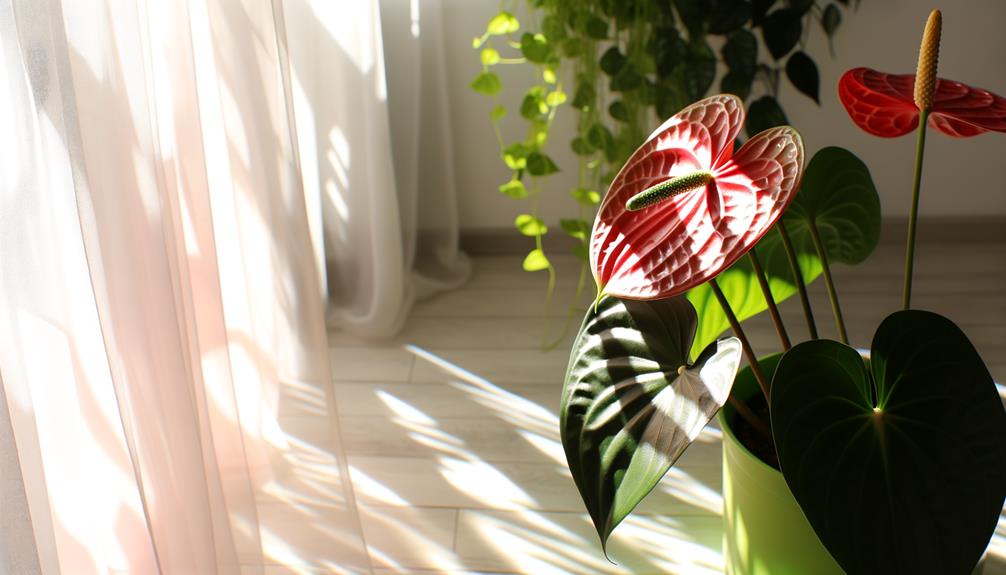
To guarantee your Anthurium thrives, place it in a location with bright, indirect sunlight.
Avoid direct sunlight, as it can scorch the leaves and hinder growth.
Indoors, a spot near a north or east-facing window provides ideal light conditions.
Optimal Sunlight Exposure
Anthurium plants thrive best in bright, indirect sunlight, making it essential to place them near a window with filtered light to avoid scorching their delicate leaves. To ensure optimal plant growth, follow these guidelines:
- Sunlight duration: Aim for about 6-8 hours of natural light daily. This duration supports healthy foliage and vibrant blooms.
- Indoor placement: Position your Anthurium near an east or north-facing window. This allows ample indirect sunlight without harsh rays.
- Natural light: Utilize sheer curtains to diffuse the light if your window gets too much direct sun. This prevents leaf burn and promotes sustained growth.
Avoid Direct Sunlight
Direct sunshine can cause severe harm to Anthurium plants by scorching their leaves and hindering their overall growth. To ensure best plant health, it’s essential to manage sunlight exposure carefully.
Anthuriums thrive in bright, indirect light. Direct sunshine can increase leaf temperature, leading to dehydration and cell damage.
Here’s a quick reference table for sunlight requirements:
| Light Condition | Effect on Plant | Care Tips |
|---|---|---|
| Direct Sunlight | Scorched leaves, stunted growth | Use sheer curtains or relocate |
| Bright Indirect Light | Optimal growth, healthy leaves | Place near east-facing window |
| Low Light | Slowed growth, fewer flowers | Supplement with artificial light |
Indoor Light Preferences
For best growth, position your Anthurium in a spot where it receives vivid, indirect light, such as near an east-facing window. Anthuriums thrive in natural lighting, but they can also adapt to artificial lighting if necessary.
Avoid placing them in direct sunlight, which can scorch their leaves. If your home has limited natural light, consider using fluorescent or LED grow lights.
Here are some tips:
- Bright spots: Ensure the plant gets plenty of filtered light to promote blooming.
- Low light areas: While Anthuriums can tolerate lower light, their growth may slow, and flowering could be less frequent.
- Artificial lighting: Use grow lights to supplement natural light, especially during shorter days or in darker rooms.
Keep these points in mind for prime Anthurium care.
Watering Guidelines
To achieve the best growth, you’ll need to water your Anthurium plant thoroughly but allow the top inch of soil to dry out between waterings. This balance is critical to prevent root rot.
Monitor humidity levels closely; Anthuriums thrive in high humidity environments. As a result, consider plant placement in a bathroom or kitchen where humidity is naturally higher.
Watering frequency depends on your home’s environment; typically, once a week is sufficient. Make sure your pot has good drainage to avoid waterlogging.
Check the saucer under the pot regularly and empty excess water to maintain ideal soil moisture. By following these watering guidelines, you’ll support healthy growth and vibrant blooms in your Anthurium plant.
Soil and Potting

Choosing the right soil mix and pot is just as crucial as proper watering for your Anthurium plant’s health and growth. Here’s what you need to know:
- Soil Composition: Use a well-draining, airy mix. A blend of orchid bark, peat, and perlite is ideal. This guarantees proper aeration and moisture retention.
- Drainage Considerations: Make sure your pot has drainage holes. Poor drainage can lead to root rot, stunting your plant’s growth.
- Pot Size and Repotting Frequency: Choose a pot that’s just slightly larger than the root ball to prevent waterlogging. Repot every 2-3 years to refresh the soil and provide room for growth.
Fertilization Tips
While fertilizing your Anthurium, make certain you use a balanced, water-soluble fertilizer diluted to half strength to promote healthy growth and vibrant blooms. Fertilize monthly during the growing season, which typically spans from March to September.
The benefits of this growth technique are manifold: consistent nutrient supply supports robust foliage and frequent flowering. Apply the fertilizer after watering to prevent root burn. Make certain your fertilizer contains essential nutrients like nitrogen, phosphorus, and potassium, along with micronutrients such as magnesium and calcium.
Avoid over-fertilization, as it can lead to nutrient imbalances and salt buildup in the soil. By adhering to these fertilization tips, you’ll enhance your Anthurium’s overall health and aesthetic appeal, guaranteeing it thrives year-round.
Common Pests and Diseases
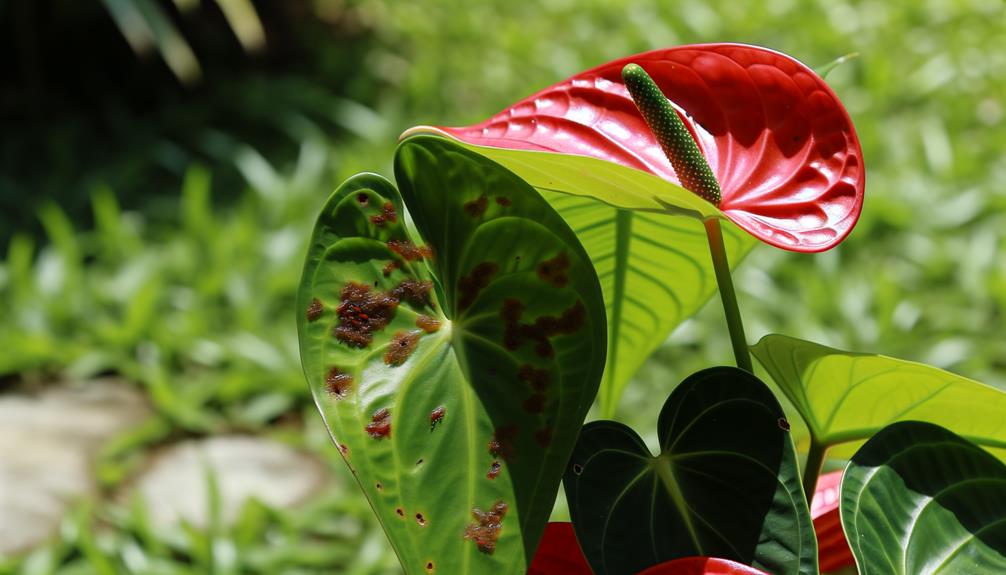
Despite your best efforts in maintaining excellent care, Anthurium plants can still fall victim to common pests and diseases that may threaten their health and vibrancy.
Here are three primary issues to watch out for:
- Spider Mites: These pests can be controlled using natural predators like ladybugs or by applying insecticidal soap. Regular misting also helps in prevention.
- Root Rot: This common disease is usually caused by overwatering. Ensure proper drainage and use a fungicide as a treatment option if necessary.
- Bacterial Blight: Characterized by yellowing leaves and wilting, it can be managed by removing affected parts and applying antibacterial treatments.
Propagation Methods
You can propagate Anthurium plants through two primary methods: division and stem cuttings.
To use the division method, gently remove the plant from its pot and separate the root clumps, making sure each division has roots and leaves. Replant them in fresh soil.
For stem cuttings, select a healthy stem with a few leaves, and cut just below a node. You can opt for water propagation by placing the cut end in water until roots form, then transfer to soil. Alternatively, use air layering by wrapping a moist sphagnum moss around a stem section, then covering with plastic until roots develop.
Both methods guarantee healthy growth and expansion of your Anthurium collection.
Conclusion
Caring for anthuriums isn’t just about keeping a plant alive; it’s about understanding their rich symbolism and historical significance.
By choosing the right species, providing proper light, soil, and fertilization, you’ll cultivate a thriving plant.
Although some believe anthuriums bring good fortune, scientific evidence suggests their beauty and air-purifying qualities genuinely enhance your environment.
Follow these guidelines and you’ll not only grow a beautiful plant but also create a meaningful connection to nature’s elegance.



